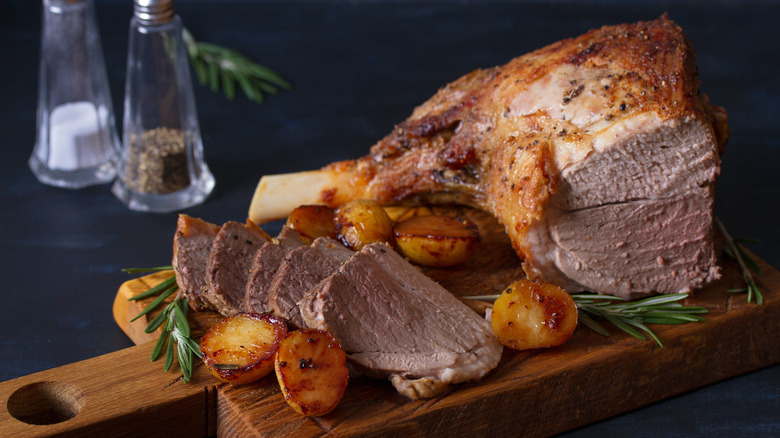For The Best Leg Of Lamb, You Don't Even Need A Marinade
Lamb is a beautiful centerpiece for a big holiday meal, but it can be just as welcome as a weeknight dinner if your family is hungry for a reliably delicious protein. And while many home chefs marinate meat without a second thought to break down some of those natural fibers, the truth is that you may be doing your beautiful cut of lamb a disservice by doing so.
This is because the leg of lamb — which is the upper thigh of the animal — is already quite tender due to its fat content. Not only does this mean you can skip any further tenderizing, but subjecting the meat to a marinade might ruin its texture altogether, breaking down so many of those fibers that your meat becomes unpleasantly mushy. Given that lamb leg can already be a bit pricey and requires some time to roast properly, it's not worth the risk — your best bet is to skip the marinade altogether.
How to give your lamb flavor without a marinade
While a marinade is primarily functional in that it tenderizes your meat, it also provides plenty of flavor. Since you're skipping the marinade for your leg of lamb, you'll have to seek out other strategies for enhancing its (admittedly already delicious) taste.
An ideal flavor blueprint can start with good olive oil, rosemary, garlic, kosher salt, and black pepper. From there, you can get creative. When oven-roasting your leg of lamb, aromatics will go a long way and can sit right in the same pan as your meat. In addition to garlic, other alliums (that produce that makes you cry) like shallots, onions, or leeks will also work nicely to elevate the dish.
Swap out or combine your rosemary with herbs like sage, thyme, bay leaves, or oregano. Lemon is also a welcome addition and brightens the dish up a bit, but you can even opt for clementines or oranges. Add cumin or paprika to your salt-and-pepper blend and rub it all over your lamb for extra flavor (you can make a few incisions and stash extra seasoning inside), or experiment with infused olive oils instead of the standard version. Dijon or a classic honey mustard wouldn't hurt either, if those flavors appeal to you.
Carving your lamb leg
Once you've cooked the meat to your preference, it's time to carve. While the pressure may feel high, you only need a cutting board and a good, sharp chef's knife to break down your meat.
Start by finding the bone and noting where it sits within the leg. With the knife, cut down at a 90-degree angle until you hit the bone. (When you do so, make sure you cut against the grain.) Then, just carve across the leg to create a slice. Repeat this from one end of the leg to the other until you have a row of slices still attached to the bone. From there, position your knife so it's parallel to the bone and start removing your slices, cutting off as much as you can to make the most of that perfectly seasoned meat. Set those slices aside on your serving tray, and make a foil tent to keep them toasty.
Once you've removed as much meat as you can with this method, use your knife to carefully excise any straggling bits still on the bone. After investing in a leg of lamb and creating all that beautiful flavor, you'll want to eat every last bite.


